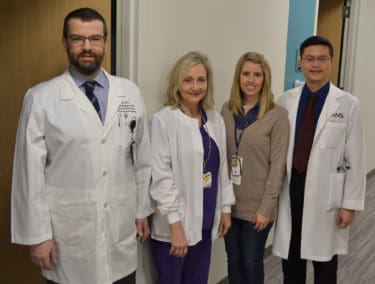Study: CPAP Aids Weight Loss in Obese Patients with Obstructive Sleep Apnea
| Use of a continuous positive airway pressure (CPAP) machine in conjunction with dietary changes can aid in weight loss in specific patients, researchers at the University of Arkansas for Medical Sciences (UAMS) found in a study that is being highlighted by an international professional society for endocrinology.
Yuanjie Mao, M.D., Ph.D., is the lead researcher on the study and is a fellow physician in the Division of Endocrinology and Metabolism in the UAMS College of Medicine Department of Internal Medicine. The study is being featured at the Endocrine Society’s annual meeting, ENDO 2019, March 23-26 in New Orleans.
“This study highlights the importance of sleep quality and hints at the possible underlying neuroendocrine changes associated with poor sleep,” Mao said. “These results suggest that physicians should recommend a combination of weight loss and CPAP treatment for obese patients with obstructive sleep apnea.”

Yuanjie Mao, M.D., Ph.D., far right, and his research team, from left: Peter Goulden, M.D.; nutritionist Jan Wall; and nutritionist Laura Quick.
The most common cause of obstructive sleep apnea in adults is obesity. Wearing a CPAP machine during sleep is the first-line treatment. However, some people may think the CPAP will not be needed if they lose weight and attempt to lose weight without initiating CPAP treatment.
In contrast, this study found that when obese people who have obstructive sleep apnea try to lose body weight by dietary calorie restriction, starting CPAP machine treatment can actually result in more body weight loss.
The study looked at patients undergoing a 16-week intensive calorie restriction program that included exercise, weekly individual counseling and cognitive behavioral therapy. Some in the group with sleep apnea were treated with CPAP and others were not. The CPAP-treatment group saw a larger absolute weight loss than the non-CPAP group.
The prevalence of obesity has been recognized as a worldwide pandemic. Obesity is abnormal or excessive fat accumulation and is associated with earlier death related to several conditions, such as type 2 diabetes and cardiovascular diseases.
Worldwide, obesity increased by 47.1 percent in children and by 27.5 percent in adults between 1980 and 2013. In 2016, globally 39 percent of adults were overweight, and 13 percent were obese. In Arkansas, 34.7 percent of adults were overweight, and 35.9 percent of adults were obese.
Obstructive sleep apnea occurs when the muscles in the throat intermittently relax during sleep and block the patient’s airway. CPAP machines are worn over the nose or mouth and use a constant stream of air to keep the patient’s airways open as they sleep.
Mao is one of four participants in the Endocrinology and Metabolism Fellowship at UAMS. Peter Goulden, M.D., associate professor of endocrinology and metabolism, oversaw Mao’s work. At the Endocrine Society meeting, Mao’s work was selected for presentation and was featured for its especially newsworthy findings.
The Endocrine Society is the world’s oldest and largest organization of scientists devoted to hormone research and physicians who care for people with hormone-related conditions. Endocrinologists are at the core of solving the most pressing health problems of our time, from diabetes and obesity to infertility, bone health, and hormone-related cancers. The society has more than 18,000 members, including scientists, physicians, educators, nurses and students in 122 countries. To learn more about the Society and the field of endocrinology, visit our site at www.endocrine.org.
UAMS is the state’s only health sciences university, with colleges of Medicine, Nursing, Pharmacy, Health Professions and Public Health; a graduate school; a hospital; a main campus in Little Rock; a Northwest Arkansas regional campus in Fayetteville; a statewide network of regional campuses; and eight institutes: the Winthrop P. Rockefeller Cancer Institute, Jackson T. Stephens Spine & Neurosciences Institute, Harvey & Bernice Jones Eye Institute, Psychiatric Research Institute, Donald W. Reynolds Institute on Aging, Translational Research Institute, Institute for Digital Health & Innovation and the Institute for Community Health Innovation. UAMS includes UAMS Health, a statewide health system that encompasses all of UAMS’ clinical enterprise. UAMS is the only adult Level 1 trauma center in the state. UAMS has 3,275 students, 890 medical residents and fellows, and five dental residents. It is the state’s largest public employer with more than 12,000 employees, including 1,200 physicians who provide care to patients at UAMS, its regional campuses, Arkansas Children’s, the VA Medical Center and Baptist Health. Visit www.uams.edu or uamshealth.com. Find us on Facebook, X (formerly Twitter), YouTube or Instagram.###
